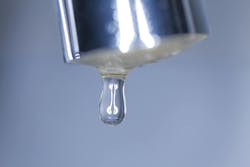IAPMO applauds federal water sustainability legislation
The International Association of Plumbing and Mechanical Officials (IAPMO®) voiced it support for the Water Efficiency, Conservation, and Sustainability Act of 2023, which would provide resources to communities to implement water-efficiency upgrades and to establish programs that repair leaks.
The legislation was introduced by Sen. Alex Padilla (D-CA) and U.S. Rep. Mike Levin (D-CA)
IAPMO said that it is especially proud that the legislation includes grants to states, tribal governments and local authorities that adopt IAPMO’s Water Efficiency and Sanitation Standard for the Built Environment (WE•Stand).
Federal spending on energy efficiency and renewable energy has outpaced spending on water efficiency and reuse by approximately 80:1 since 2000, according to Sen. Padilla’s office, resulting in millions of gallons of water wasted each year that could otherwise be stored or utilized. With water shortages expected in some portion of 40 of the 50 states, the legislation would address three primary areas:
- Water Efficiency and Conservation Grant Program: Provides funding to states, municipalities, and water systems to carry out water efficiency incentive and direct installation programs. Authorizes $50 million/year for five years.
- Sustainable Water Loss Control Program: Provides funding and technical assistance to conduct annual water audits, implement controls to address losses, and establish water loss control programs. Authorizes $40 million/year for five years.
- Assistance for Water Efficient Plumbing Code Adoption: Provides funding to state, local, and tribal governments to assist in the voluntary adoption and implementation of model water-efficient plumbing codes, including IAPMO’s WE•Stand. Authorizes $20 million/year for five years.
Developed and subsequently republished at the conclusion of each three-year code cycle, IAPMO said that WE•Stand is designed to provide progressive codified requirements to optimize water use practices attributed to the built environment while maintaining protection of the public health, safety, and welfare. Its key provisions include water efficiency and conservation requirements, IAPMO’s Water Demand Calculator™, alternate water sources for nonpotable applications such as gray and reclaimed water systems, potable and nonpotable rainwater catchment systems, non-sewered sanitation systems, leak detection and control, and vacuum drainage systems.
“As the Western United States and much of the Southeast continue to experience significant droughts, investing in resilient water supplies is an increasingly urgent priority for communities facing rising water rates,” Sen. Padilla said. “Water efficiency and conservation measures are fast and cost-effective solutions to ensure clean drinking water, to lower water bills, and to bolster a drought-resilient water supply. We must work to modernize our water infrastructure and make it more efficient — we all have a stake in this fight.”
